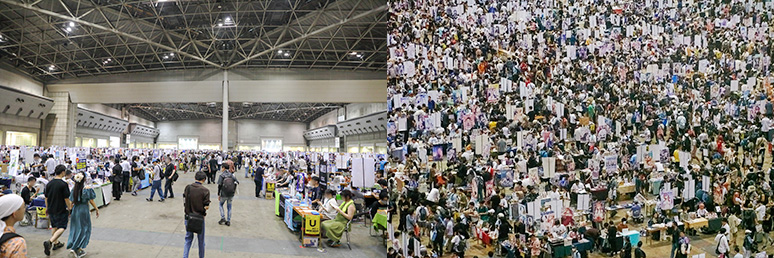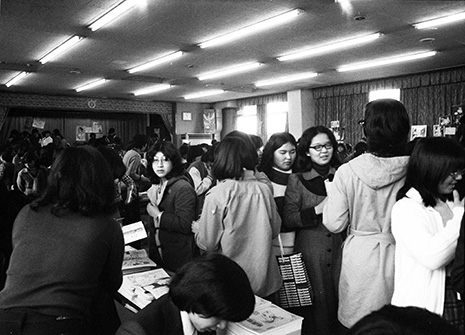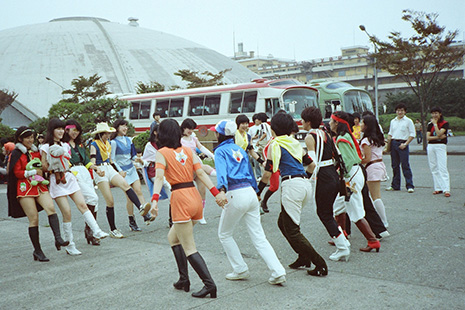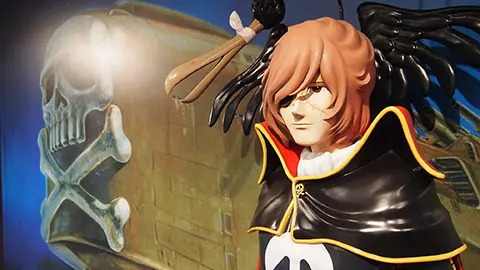VOL.195 AUGUST 2024
EXPLORE THE UNIQUE CHARM OF MANGA IN JAPAN
Comic Market, The World’s Largest Doujinshi Convention

A look at the Comic Market that was held in the summer of 2024
Photo: (Left) ISHIZAWA Yoji, (Right) Comic Market Preparatory Committee
Comic Market, commonly known as “Comiket,” began in 1975 and is the world’s largest comic exhibition and sale of doujinshi (non-commercial, self-published works). This article introduces the world of doujinshi manga, a genre that allow readers to enjoy the free thinking and expressions of each individual amateur creator.
Doujinshi* have been a grassroots force behind Japan’s manga boom, and the Comic Market (Comiket), a convention where these self-published doujinshi are exhibited and sold, is an essential part of this movement’s story.
Comiket is held twice a year, in summer and winter, usually in mid-August and at the end of December. Most recently, Comic Market 104 was held at Tokyo Big Sight on August 11-12, 2024, attracting a total of about 260,000 visitors over the two days, with around 24,000 circles (groups or individuals who create the works) exhibiting and distributing doujinshi. Since the first one held in December 1975, the event’s scale has gradually continued to grow. Participation at Comic Market 97 (December 28-31, 2019), held just before the COVID-19 pandemic, reached a record high of about 750,000 visitors and 32,000 participating circles over the four-day period; many companies, including publishers and game companies, also exhibited, making it one of the world’s largest doujinshi manga sales events.
ICHIKAWA Koichi, co-chairman of the Comic Market Preparatory Committee, which organizes the event, said, “Japan’s towns have always had many printing houses with advanced printing technology, making it easy for anyone to place their own self-publishing order. In the 1970s, when the popularity of manga was growing, manga research clubs at universities and other institutions all over Japan published nicely printed doujinshi,” he recalls. Back then, there were no social networking services like we have today, and the only way for manga fans to communicate with each other was through the Reader Pages of magazines. The first Comiket was held in December 1975 to try to create a forum where these like-minded people could meet together.
“We rented a room in a hall in Tokyo, held an exhibition and sale, and 700 people came from all over the country,” ICHIKAWA says.

Photo: Comic Market Preparatory Committee
In the 1980s, the anime boom heated up. Captain Tsubasa** and a great number of other fan-fiction*** works came out, attracting female fans and giving Comiket’s popularity a boost. According to SATOMI Naoki of the Preparatory Committee for Public Relations, it was around this time that more and more cosplayers**** pretending to be characters from their favorite works began to attend the event.
“Every year of the 1990s saw over 200,000 participants, and the number eventually broke 400,000. This made a larger venue a necessity. Now, the event is held at Tokyo Big Sight in Ariake, Koto City, Tokyo. We now have to provide a huge number of changing rooms for the cosplayers.”

Photo: Comic Market Preparatory Committee
In 2019, just before the COVID-19 pandemic, there were 700,000 total visitors and over 30,000 circles. Add a total of 20,000 to 30,000 participating cosplayers, and Comiket had become one of not only Japan’s but also the world’s largest events. Nevertheless, the event is still run by volunteers, just as it was first launched. This is both surprising and admirable.
“The Comic Market Preparatory Committee runs the event, and it has about 3,000 people. Even so, the general public and volunteers from circles help free of charge with setting up the day before and taking down the exhibits after the event.”

A look at setting up the event the day before. Numerous volunteers contributed to the setup, starting their work early in the morning.
Photo: Comic Market Preparatory Committee
“It has continued for nearly half a century because it has been an important place to so many people, and I hope it will keep going into the future. I’m also truly proud and happy that Comiket has popularized people like HIRANO Kouta****** and YOSHINAGA Fumi,******* who are now active as professional manga artists.”

Photo: ISHIZAWA Yoji
Photography cooperation: ARIMA Shuujou, KOZUKI Azu
ICHIKAWA says that with more than 50,000 different doujinshi available at a single event, “The appeal of Comiket is that you can always find something you like.” SATOMI adds that recent years have seen many participants from outside Japan.
“Since we receive so many inquiries from overseas participants, we have set up a special department called the International Department to handle them. At the most recent event, we had participants from at least 75 countries. However, participation in this event as a circle (booth exhibitor) is limited to those who possess a Japanese address for receiving our documents. A lot of booth exhibitors from overseas make books in Japanese, which is not their native language, and some distribute doujinshi in Korean and Chinese. Before, we had quite a lot of visitors from overseas who came just to sightsee, but recently so many people are diligently researching the circles of the authors in whom they have an interest before they come. People from Africa and South America also come, which makes me sense the international popularity of Japanese manga. Anyway, there are many people, and you’ll have to wait in line at this event more often than you might imagine. Comiket is held whether it is hot or cold out, so I hope everyone will take all possible measures to protect themselves from heat and cold and participate safely and happily.”
* A booklet produced, at their own expense, by a group of friends who share the same interests and hobbies. It is said that its roots in Japan date back to the Meiji period (1868-1912). There are records that writers of literary works at the time enjoyed making booklets with their friends.
** A Japanese soccer manga by TAKAHASHI Yoichi. Also including fan-fiction works based on it.
*** Refers to the expressive act of creating a new work based on an existing work. A manga, anime, game, etc., which is adapted from an earlier manga, anime, game, etc., in a style of expression unique to each secondary creator, and distributed in various forms, including doujinshi and illustrations.
**** Cosplay is an abbreviation of “costume play,” the act of dressing up as a character from a manga, anime or game. People who do it are called “cosplayers” or “layers.”
***** A traditional Japanese game passed down from olden times. Participants are divided into two groups, and each group walks hand in hand while singing a song and exchanging members with the other group. In the 1990s, it was popular for cosplayers to interact by playing Hana Ichi Monme.
****** HIRANO Kouta is a manga artist who mainly creates action and comedy works. His major works include HELLSING and DRIFTERS.
******* A Japanese manga artist whose major works include Ooku: The Inner Chambers and What Did You Eat Yesterday?
By MOROHASHI Kumiko
Photo: Comic Market Preparatory Committee; ISHIZAWA Yoji

